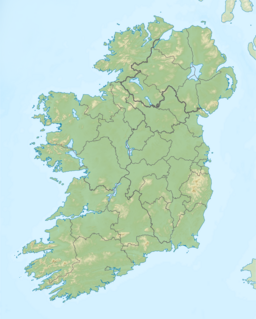| Keshcarrigan Lough | |
|---|---|
| Ceis Charraigín Loch (Irish) | |
| Location | County Leitrim |
| Coordinates | 54°01′50″N 7°57′26″W / 54.03056°N 7.95722°W |
| Lake type | Freshwater |
| Basin countries | Ireland |
| Surface area | 0.39 km2 (0.15 sq mi) |
| Max. depth | 4 m (13 ft) |
| Surface elevation | 62 m (203 ft) |
| Islands | 1 |
| References | [1][2] |
Keshcarrigan Lough (Irish: Ceis Charraigín loch, meaning 'Kesh, or causeway, near the little rock, lake')[3] is a mesotrophic freshwater lake near Keshcarrigan in County Leitrim, Ireland. Known for quality coarse fishing, the lake allows bank fishing from concrete stands on the northern shore, two with wheelchair access.[1] The ecology of Keshcarrigan Lough, and other county waterways, is threatened by curly waterweed, zebra mussel, and freshwater clam invasive species.[4][5]
YouTube Encyclopedic
-
1/1Views:1 106
-
Where To Fish In Ireland Vol. VI.4
Transcription
Etymology
The lake is named from the bordering townland of "Keshcarrigan" (Irish: Ceis Charraigín), meaning the "Kesh, or causeway, near the little rock".[3]
Geography
Keshcarrigan Lough lies due south of Keshcarrigan village and Lough Scur, in Kiltubrid parish in south County Leitrim. The lake forms a tilted oblong shape, with a surface-area of 0.39 square kilometres (0.2 sq mi),[1][6] with depths of 4 metres (13.1 ft).[1] The level of Keshcarrigan Lough is the same as Lough Scur, and a channel of about 400 metres (1,312.3 ft) connects both lakes.[6] The lake is bounded by the townlands of Keshcarrigan to the north, Clooney to the south, Laheen to the west, Carrick to the north, and Toomans to the east.
Ecology
Fish present in Keshcarrigan Lough include "roach-bream hybrids", Roach, Perch, Bream up to 4lbs, and Pike.[1][7] The pike population is the "native Irish strain" (Irish: liús meaning 'Irish Pike') not the other European Pike strain (Irish: gailliasc meaning 'strange or foreign fish').[4] The lake has stocks of Pike up to 8 pounds (3.6 kg).[1]
Crayfish
A thriving population of white-clawed crayfish was reported here in 2009.[8] Keshcarrigan Lough, with a shallow rocky shore, has some ideal potential white-clawed crayfish habitat,[9] but the ecology is seriously threatened by zebra mussel infestation,[10] and indiscriminate importation of non-indigenous crayfish species.[11]
Human settlement
The primary human settlement at Keshcarrigan Lough is the village of Keshcarrigan.
See also
References
Citations
- ^ a b c d e f anglingireland.
- ^ Joyce 1883, pp. 173.
- ^ a b logainm.ie, pp. Ceis Charraigín.
- ^ a b Pedreschi et al. 2014.
- ^ Clenaghan, Clinton & Crowe 2005, pp. 16.
- ^ a b MacMahon 1845, pp. 23.
- ^ discoverireland.ie 2017.
- ^ O’Connor et al. 2007, pp. 66.
- ^ O’Connor et al. 2007, pp. 39–40.
- ^ O’Connor et al. 2007, pp. 30.
- ^ Reynolds 2011, pp. 124.
Sources
- Joyce, Patrick Weston (1883) [1883]. The Geography of the Counties of Ireland (PDF).
- anglingireland. "Satellite Pike Waters in the Ballinamore and Keshcarrigan area". Inland Fisheries Ireland. Retrieved 5 August 2015.
- MacMahon, John (1845). Correspondance relative to the navigation between Lough Erne and the River Shannon (Report). Vol. Parliamentary Papers, House of Commons and Command, Volume 45 (Digitized 2006 from original in Harvard University ed.). H.M. Stationery Office.
- Reynolds, Julian D. (2011). Rees M; Nightingale J; Holdich DM (eds.). White-Clawed Crayfish in Ireland - under increasing threat. Vol. Species Survival: Securing white-clawed crayfish in a changing environment. Proceedings of a Conference held on 16 and 17 November 2010 in Bristol, UK. pp. 120–128.
- Pedreschi, D.; Kelly-Quinn, M.; Caffrey, J; O'Grady, M.; Mariani, S.; Phillimore, A. (2014), "Genetic structure of pike (Esox lucius) reveals a complex and previously unrecognized colonization history of Ireland", Journal of Biogeography, 41 (3), Journal of Biogeography, 41(3), 548–560.: 548–560, doi:10.1111/jbi.12220, PMC 4238397, PMID 25435649
- O’Connor, William; Hayes, Gerard; O'Keeffe, Ciaran; Lynn, Deirdre (2007). Monitoring of white-clawed crayfish Austropotamobius pallipes in Irish lakes in 2007 (PDF) (Report). Vol. Irish Wildlife Manuals No. 37. Environment, Heritage and Local government.
- discoverireland.ie (2017). "Coarse Angling Keshcarrigan".
- Clenaghan, Conor; Clinton, Frank; Crowe, Matthew (2005). Phosphorus Regulations National Implementation Report (PDF) (Report). Environmental Protection Agency, Office of Environmental Enforcement.


